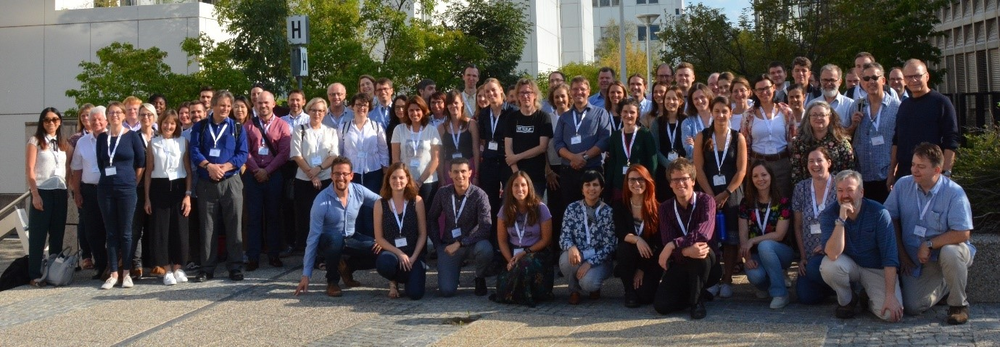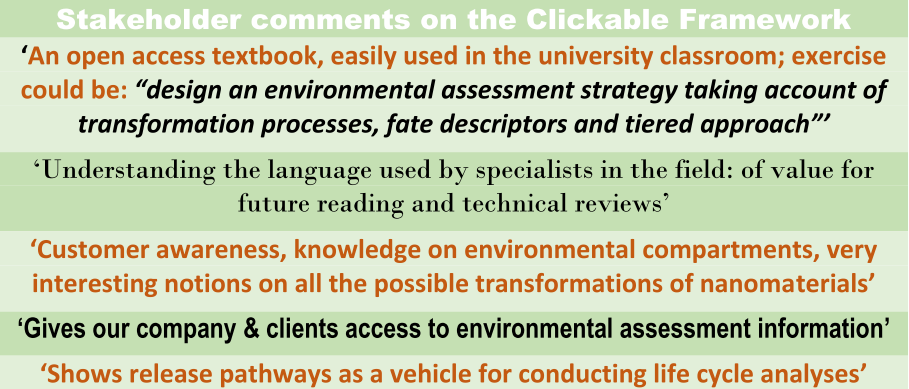Stakeholder Talks at NanoFASE Concluding Conference – Vienna, September 2019

Thanks to Water and Sediments lead investigator Frank von der Kammer for hosting the NanoFASE Concluding Conference at UniVie on 5-6 September 2019. It took place immediately after ICEENN 2019, where NanoFASE authors provided 21 plenary presentations.
For our Concluding Conference we invited a panel of Regulatory, Industry and Academic stakeholders from our Advisory Board and project partners to reflect on NanoFASE, the Clickable Framework and the way forward.

Beyond our Vienna panellists quoted below, NanoFASE thanks all our practical industry partners who synthesised experimental materials (Promethean bespoke particles), developed advanced instrumentation (PerkinElmer for (sp)ICP-MS), or tested nano-enabled products (FCCCO, Hempel)! Find more feedback to us from these partners here.
Andrzej Kinart (Amepox)
Flagship product: Nanosilver inks for ink-jet printed electronics and new Thermal Interface Materials (TIM). 2017 Space Exploration Masters Sustainable Exploration Prize for intelligent satellite sails: printed circuitry enabling communications, sensor signals and controls.
Participation in NanoFASE allowed this Polish SME to maximise the purity of their inks’ silver filler, reducing sintering temperatures, and resulting in an extremely high thermal conduction coefficient enabling circuitry to function in the high vacuum environment of space. Other product innovations include colloidal nanosilver in water (sized 3-8 and 50-60 nm), and experimental high purity silver nanowires. The NanoFASE lifecycle release pathway analysis for ink illustrated that the Amepox process produces no silver waste (all remaining silver after wet AgNP synthesis is collected and reused in silver powder and flake components).
Martí Busquets (Applied Nanoparticles - AppNps)
Flagship product: BioGAS+, a nanomagnetite-based additive boosting production up to 185%.
This Catalan spin-off ‘empowers researchers’ by designing, supplying and advising on model inorganic NPs with high morphology and monodispersity control, and high-quality concentrated and stable NP colloids. Within NanoFASE, AppNps created a new 20 nm AG2S NP as an analogue of sulfidized Ag NPs in soils. They developed improved synthesis and post-synthesis processes to meet partners’ requirements on quantity and concentration. They scaled up production with a one-pot seeded-growth strategy, providing Master Batches for experimental work across the NanoFASE consortium. Busquets invites future collaboration on ‘the nanoparticles of your dreams’ as well as AppNps innovations such as chemically and fluorescently labelled micro/nanoplastics.
Olga Chybová (inoTEX)
Flagship product: Texaktiv TiO2 (nanoTiO2 dispersion and binder) for photocatalytic self-cleaning curtains, filters, upholstery, etc.
In a Czech national project, inoTEX developed coating technology for polymers to carry active antimicrobial components in selected textiles. Participation in NanoFASE supported the technology evaluation for Alterbio (stabilized nanosilver polyethyleneimine). A waterproofed tent canvas incorporating the polymer was assessed on release processes, rates, and proportion of nanoforms in such release. Alterbio is now market-ready. NanoFASE also tested Texaktiv TiO2 as well as antimicrobial textiles incorporating inoTEX’s experimentally produced silver nanowires and NPs. Chybová reported that the life cycle release data supported marketing and increased customer confidence, and will be used for new nano-enabled functional product development. Knowledge built with NanoFASE collaboration also added value to the company’s ‘everyday’ local and regulatory interactions.
Patrick Hole (Malvern Panalytical)
Flagship product: Malvern Panalytical NanoSight NS300 Instrument and NanoSight Sample Assistant for increased throughput and reproducibility in nanoparticle characterisation.
Hole recalled the NanoFASE kick-off meeting where he chatted with scientists about their challenges in Nanoparticle Tracking Analysis (NTA, used to obtain the particle size distribution and concentration of nanoparticles in liquid suspension). Quality of results depends as much on sample handling as instrument capability, and Hole considered it Malvern’s responsibility to address issues such as cross-contamination or bubbles. During the project Malvern Panalytical therefore developed an autosampler demanding under 30 minutes of set-up time and ensuring treatment of 96 samples in as little as 15 hours - analysis of nano zerovalent iron samples from NanoFASE partner TUL could thus run overnight without human intervention. Repeatability is shown to be better than that obtained by the expert user. The sample assistant, providing multi-user and multi-experiment support, is now an "off the shelf" product.

Anu Kapanen (ECHA) and Sean Kelly (NIA) each recognized the impact of the 2018 REACH Annexes revision, augmenting the evidence required to justify nanoform sets. There is an urgent need to develop standard methods for studying environmental transformation processes, grouping and read across, and modelling.
| For Anu Kapanen as regulator, NanoFASE has added value by increasing understanding of the fate and exposure of ENMs: covering the different environmental compartments and processes, bringing out fate descriptors (attachment efficiency and rate, dissolution rate constant, sedimentation rate, sulfidation rate constant); and providing a variety of models. NanoFASE has achieved ‘a leap’ in developing protocols and procedures and contributing to standardisation; designing an Exposure Assessment Framework and reinforcing the regulatory-accepted SimpleBox4nano screening model; grouping based on fate properties; and creating public access to the Clickable Framework. |
For Anu Kapanen as regulator, NanoFASE has added value by increasing understanding of the fate and exposure of ENMs: covering the different environmental compartments and processes, bringing out fate descriptors (attachment efficiency and rate, dissolution rate constant, sedimentation rate, sulfidation rate constant); and providing a variety of models. NanoFASE has achieved ‘a leap’ in developing protocols and procedures and contributing to standardisation; designing an Exposure Assessment Framework and reinforcing the regulatory-accepted SimpleBox4nano screening model; grouping based on fate properties; and creating public access to the Clickable Framework.
Kai Paul (Blue Frog Scientific Limited) defined ten ‘routine’ consultancy questions that arise when addressing REACH evidence requirements. He showed how the Clickable Framework can support fact-finding, assessment and weight-of-evidence. Online access to protocols and the overall knowledge base should be improved. Paul pointed to open research questions such as the need for bioaccumulation cut-off levels, or whether it is possible to use aquatic tox endpoints to estimate sediment and soil tox endpoints.
|
Consultant Kai Paul concluded that the Clickable Framework opens access to critical principles (e.g. algorithms and their inputs), critical research (for instance NanoFASE Report D4.2 Release estimates), some protocols, and models (Tier 1 and higher). To complete REACH dossiers it is best used in conjunction with guidelines (e.g. ECHA 2017). |

Wendel Wohlleben (BASF) analysed the extent to which current research and knowledge address urgent questions that arise in view of REACH requirements for 2020. NanoFASE helps identify which properties and (functional) assays are necessary and sufficient to assess similarity for grouping; and which compartments shall (or should) be prioritized for environmental risk assessment.
Gregory Lowry (Carnegie Mellon) recalled how in 2008 CEINT identified which model systems were required to assess environmental exposure and effects – at the time there was little idea of how to make them work for nano. Citing Dale et al. (2015 ES&T 49/12) Lowry showed the importance of e.g. achieving spatiotemporal resolution: particle loads across river systems can vary by an order of ten, and seasonal efflux by an order of four. Models need to emphasise simplicity without compromising realism. Lowry reviewed NanoFASE contributions to addressing key questions, and looked forward to collaborations addressing today’s gaps on e.g. disaggregation, resuspension, linking models to bioaccumulation and toxicity, ensuring decision-making outputs, and model validation (‘consistency between models is not a validation of realism – are 5km2 grids enough?’).
|
Greg Lowry showed how NanoFASE has made strides in filling knowledge gaps: providing data on emissions; improving descriptions of heteroaggregation, transport, and reactive nanomaterial chemistry; developing labelled particles to enable environmental tracing. He said that NanoFASE has been especially successful in parametrizing modelling by coordinating the design and execution of experiments to collect the needed values. |
Jason Unrine (U. of Kentucky) presented thoughts on bioavailability and toxicokinetics, hitting the highlights of numerous major papers published by NanoFASE collaborators. Unrine pointed to remaining questions: bioavailability and trophic transfer of particles with low solubility particles, polymers, or nanocarriers of agrochemicals/bionanomaterials; foliar and seed exposures. He concluded that NanoFASE did an ‘incredible job’ developing tools and frameworks to organize knowledge of fate and transport. These were grounded in mostly metal-based NPs in consumer product contexts, and should now be applied to higher-exposure, more sophisticated materials and uses. Unrine viewed that indirect effects of NMs can be more important than direct effects.
Francisco Huertas (ITENE) showed what the tiered Environmental Exposure Assessment framework and other NanoFASE work offers to the Spanish institute’s NanoSafety Services and Expertise group. Industry regulatory compliance and decision making are supported by taking into account release ratios, NP fate and behaviour, alongside new modelling approaches. National R&D can exploit an ability to determine hotspots due to industrial release. Finally, NanoFASE learning is meaningful to ITENE’s European collaborations including Interreg Sudoe, NanoDESK, NanoXplore, NanoMONITOR, NanoRIGO and BIORIMA.
Christine Hendren (CEINT, Duke University) and Iseult Lynch (University of Birmingham) each spoke of integrating international nanomaterials communities around FAIR data generation, data management and nanoinformatics approaches to support the risk and hazard assessment of ENMs. Hendrin gave a brief history of NanoInformatics Knowledge Commons (NIKC) which has provided a much-needed environmental database. No one group can generate sufficient data to address questions raised by the complexity of the environment; pooling interoperable data through a commitment to shared curation also lets new questions arise and enables new insights. CEINT, NanoFASE and the French project Serenade have collaborated intensively to develop curation concepts and techniques, and NanoFASE data have been entered in the base accessible now through H2020 project NanoCommons’ Transnational Access scheme.
|
Ongoing legacy of NanoFASE through sister H2020 projects The NanoCommons project will further promote the use/acceptance/implementation of the NIKC database for Europe, developed by NanoFASE partner Biomax Informatics using training materials produced in NanoFASE by Team Helium in consultation with the University of Birmingham. The Gracious project adopts NanoFASE concepts of functional fate grouping (FFG) and consideration of environmentally realistic forms of nanomaterials, adapting these in hazard assessment for ENMs. The NanoSolveIT project further enhances the utility of the NanoFASE water-soil-organism model by developing ENM-focussed integrated approaches to testing and assessment (IATA) that incorporate our model. |
